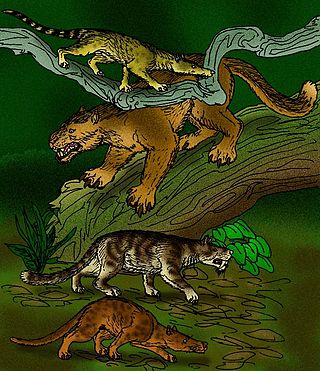
Creodonta is a former order of extinct carnivorous placental mammals that lived from the early Paleocene to the late Miocene epochs in North America, Europe, Asia and Africa. Originally thought to be a single group of animals ancestral to the modern Carnivora, this order is now usually considered a polyphyletic assemblage of two different groups, the oxyaenids and the hyaenodonts, not a natural group. Oxyaenids are first known from the Palaeocene of North America, while hyaenodonts hail from the Palaeocene of Africa.
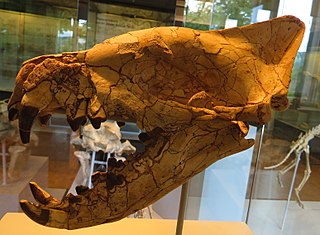
Hyaenodontidae is a family of placental mammals in the extinct superfamily Hyaenodontoidea. Hyaenodontids arose during the early Eocene and persisted well into the early Miocene. Fossils of this group have been found in Asia, North America and Europe.

Hyaenodon ("hyena-tooth") is an extinct genus of carnivorous placental mammals from extinct tribe Hyaenodontini within extinct subfamily Hyaenodontinae, that lived in Eurasia and North America from the middle Eocene, throughout the Oligocene, to the early Miocene.

Eomanis is the earliest known true pangolin from extinct family Eomanidae within suborder Eupholidota. It lived during the Eocene in Europe. Eomanis fossils found in the Messel Pit in Germany are very similar in size and anatomy to living pangolins of the genus Manis, indicating that pangolins have remained largely unchanged in morphology and behavior for 50 million years. However, unlike modern pangolins, its tail and legs did not bear scales. According to the stomach contents of the excellently preserved Messel specimens, Eomanis’ diet consisted of both insects and plants.

Viverravidae is an extinct monophyletic family of mammals from extinct superfamily Viverravoidea within the clade Carnivoramorpha, that lived from the early Palaeocene to the late Eocene in North America, Europe and Asia. They were once thought to be the earliest carnivorans and ancestral to extant ones, but now are placed outside the order Carnivora based on cranial morphology as relatives to extant carnivorans.

Miacoidea is a former paraphyletic superfamily of extinct placental mammals that lived during the Paleocene and Eocene epochs, about 66-33,9 million years ago. This group had been traditionally divided into two families of primitive carnivorous mammals: Miacidae and Viverravidae. These mammals were basal to order Carnivora, the crown-group within the Carnivoramorpha.
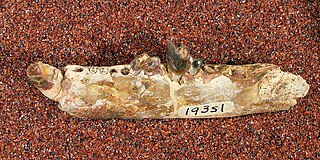
Uintacyon is an extinct paraphyletic genus of placental mammals from clade Carnivoraformes, that lived in North America from the early to middle Eocene.

Tillodontia is an extinct suborder of eutherian mammals known from the Early Paleocene to Late Eocene of China, the Late Paleocene to Middle Eocene of North America where they display their maximum species diversity, the Middle Eocene of Pakistan, and the Early Eocene of Europe. Leaving no descendants, they are most closely related to the pantodonts, another extinct group. The tillodonts were medium- to large-sized animals that probably fed on roots and tubers in temperate to subtropical habitats.

Palaeoryctidae is an extinct family of non-specialized eutherian mammals from extinct order Palaeoryctida, that lived in North America, Europe, Asia and Africa from the late Cretaceous to the middle Eocene.

Sinopa is an extinct genus of placental mammals from extinct family Sinopidae within extinct order Hyaenodonta, that lived in North America and Asia from the early to middle Eocene.
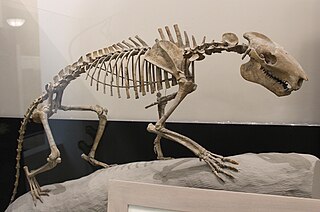
Agriochoerus is an extinct genus of scansorial herbivore of the tylopod family Agriochoeridae, endemic to North America. Agriochoerus and other agriochoerids possessed claws, which is rare within Artiodactyla, as well as likely being scansorial. Agriochoerus was first described in 1869.

Proviverra is an extinct genus of placental mammals from extinct family Proviverridae within extinct superfamily Hyaenodontoidea, that lived during the Middle Eocene in Europe.

Palaeonictis is an extinct genus of placental mammals from extinct subfamily Palaeonictinae within extinct family Oxyaenidae, that lived in Europe and North America from the late Paleocene to the early Eocene.

Hyaenodonta is an extinct order of hypercarnivorous placental mammals of clade Pan-Carnivora from mirorder Ferae. Hyaenodonts were important mammalian predators that arose during the early Paleocene in Europe and persisted well into the late Miocene.

Machaeroidinae ("dagger-like") is an extinct subfamily of carnivorous sabre-toothed placental mammals from extinct family Oxyaenidae, that lived from the early to middle Eocene of Asia and North America. Traditionally classified as hyaenodonts, this group is now classified as a member of the family Oxyaenidae.

Limnocyoninae is a subfamily of extinct predatory mammals from extinct order Hyaenodonta. Fossil remains of these mammals are known from late Paleocene to late Eocene deposits in North America and Asia. Limnocyonines had only two molars in the upper and lower dentition.
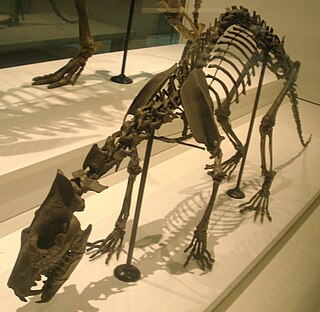
Sinopidae is an extinct family of predatory placental mammals from extinct order Hyaenodonta. Fossil remains of these mammals are known from early to middle Eocene deposits in North America, Europe and Asia.

Proviverrinae is an extinct subfamily of placental mammals within the extinct order Hyaenodonta. Fossil remains of these mammals are known from early to late Eocene deposits in Europe.

Hyaenodontinae is an extinct subfamily of predatory placental mammals from extinct family Hyaenodontidae. Fossil remains of these mammals are known from early Eocene to early Miocene deposits in Europe, Asia and North America.

Hyainailouroidea ("hyena-cats") is a superfamily of extinct predatory mammals from extinct order Hyaenodonta. Fossil remains of these mammals are known from middle Eocene to late Miocene deposits in North America, Europe, Africa and Asia. Members of this group probably originate from Afro-Arabia, a continent that remained isolated from the Albian to the Miocene. While in North America and Eurasia hyaenodonts competed with other predatory mammals, in Afro-Arabia they remained the main terrestrial predators.



















